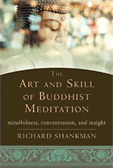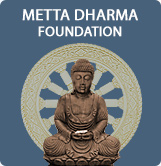
Informing Practice Through Study
Reprinted from the The Sati Journal, Volume 1
Upon embarking on any course we need to understand what we are undertaking and why. This is especially true for endeavors of great consequence, such as Dharma practice, which have the power to reshape our lives in radical ways. Buddhist contemplative practices challenge our fundamental assumptions about ourselves, our experience, and our relationship with the world around us.
If we begin meditation, or Dharma practice in any of its forms, without some perspective and framework from which to apply ourselves, our experience will unfold by chance and take us in its own direction according to our predilections and tendencies. We need to understand the purposes of Buddhist teachings and practices in order to make wise and informed choices and assess what is skillful action. Dharma unfolds uniquely for each of us. A contextual basis within which to understand what is happening and where we are going acts as a protector and guide. Without knowing where we are heading, we can often create unnecessary suffering along this path intended to lead to an end of suffering. An appreciation of the potentials, limitations, and pitfalls of whatever teachings and practices we engage in acts as an ally to inform our choices and guide how we direct our efforts.
I have had the opportunity to study and practice with a number of teachers in various Buddhist and non-Buddhist contemplative traditions, all of whom were quite different in style and content, in the practices they were teaching, and in their understanding of the goals and reasons for undertaking spiritual practices. Some were openly critical of other teachers and traditions, believing that they held the correct understanding of the true path of the spiritual life. Others were genuinely accepting and appreciative of other approaches, realizing that there are many ways to come to liberation and that there is not a single right or best path of practice, only whichever approach works best for each of us according to our individual nature and disposition.
When I began meditation practice in 1970 I was young and idealistic, without much basis for understanding the teachings. I had a vague idea of what I was seeking but little idea of the foundational teachings or goals of the practices I was undertaking. As I studied with various teachers and engaged in a variety of practices, I began to piece together a conceptual basis within which to understand what I was doing and why. Only later did I delve systematically into a thorough study of Buddhist teachings, history, and development.
The more teachings and trainings I was exposed to, especially when informed by inquiry and study, the more I understood the overall context for what I was doing. It seemed the less I knew and grasped about the range and diversity of teachings, practice styles, and goals, the more rigidly I held to certain attitudes and the more sure I was of my beliefs and views. I used to have very strong judgments and opinions about the right way to practice, the right understanding and interpretations of the path, and where the practice was heading. The more I’ve learned and been exposed to, the more open, receptive, and truly appreciative I’ve become of the great mosaic of effective methods and skillful means
As I became more educated and my understanding matured, my appreciation for the range of skillful means broadened. I saw that some practices, which worked very well for certain people, were just not a good fit for others. People seemed to have attained deep states of realization and awakening practicing in all the various styles and practices I encountered. I realized that it is not a matter of finding the right, true practice, as if there were such a thing waiting for us to discover, but finding the practice that is best for each of us. This served only to inform and strengthen my own practice.
The early Sangha did not practice in a vacuum, without an understanding of what they were doing or why. The Buddha, as recorded in the Pāli literature, did not only give meditation instructions. The entire Pāli canon is a compilation of teachings on the principles and application of Dharma practice from the Buddha and other senior disciples. Throughout his teaching career, from the time of his enlightenment until his death, the Buddha engaged in various skillful means for conveying the path and practice of liberation, presenting a framework within which to understand what they were undertaking and to set clear intentions and a context within which to hold the practice.
In those days, study looked quite different from what we may be used to today, consisting not in immersion in books, but of direct individual guidance and instruction; teachings were preserved and transmitted in an oral form, through personal transmission and presence. In the stories preserved and handed down to us from those times, senior disciples would spend hours teaching and would sometimes stay up all night discussing Dharma. From those early times and continuing throughout the history of Buddhism, practice has always been understood to be properly accompanied and informed by study to some degree
Practices that calm the mind, open the heart, and strengthen mindfulness and clear awareness can be applied toward any goal. What makes practice Buddhist, rather than secular, is the end toward which these qualities are directed. The application of Dharma practices generally improves our lives. The cultivation of mindfulness is extremely effective for reducing stress, increasing well-being, and improving concentration in any endeavor. If we can train our minds to be more relaxed, spacious, and loving, we will feel happier and our interactions with others will be easier and more pleasant. If we do not understand the aim of Buddhist teachings, which point to a complete release and end to suffering, then in our efforts to decrease stress, live with more ease, and rid ourselves of unpleasant experiences, we may miss the greater possibility of liberation from suffering that is independent of conditions. In an attempt to shift the conditions of our lives we may never learn to turn towards and meet our suffering, to come to know and understand it, and to be present and free in the midst of the reality of each moment.
Educating ourselves about the goals of practice can help unmask unexamined assumptions about ourselves and the teachings, which in turn sheds light on our motivations for practicing. Levels of clinging and identity we may have not been aware of can be revealed which, in turn, can inform clarity of intention.
As our Dharma practice develops we can become confused when we hear conflicting teachings or we enter new and unfamiliar territory in our meditation. It helps to have a map of the terrain, both in terms of meditative experiences and in applying Dharma teachings to the range of daily life situations. There is a rich array of teachings and reflections from others who have gone before us, and we can often avoid needless suffering and wasted time by familiarizing ourselves with their roadmaps for how the practical applications of the teachings can evolve. I was motivated to write my book The Experience of Samādhi precisely because there was so much confusion and misinformation floating around about the topic of samādhi (concentration) and its relation to meditation practice.
We may engage in various styles of learning, depending on our interests and needs, ranging from listening to a Dharma talk or receiving basic meditation instructions to formal, structured study, individually or in small or large group settings. Irrespective of the form of study we engage in, most importantly, the process should be relevant and applicable to our meditative and everyday experience. All of the Buddha’s teachings and practices - the entire Dharma -are not meant for intellectual understanding alone, but are intended to be applied directly in our daily lives. Study of Buddhist doctrine, history, and development may be interesting for its own sake, but if undertaken merely as an academic exercise, disconnected from and not applied to our lived experience, we miss the real worth and personal benefit it can bring. Study is of tremendous value and great reward if it informs how we think and act and brings us to a direct experiential knowing, applied directly to meet our daily lives.
Ajahn Chah, the greatly respected and beloved Thai meditation master, compared study without practical application to a ladle in a pot of soup. The ladle is in the soup, but it does not know the taste of soup. We can absorb ourselves in study, but if we want to taste the Dharma, if we wish to experience and embody the love, compassion, wisdom, and liberation pointed to by the Buddha, the teachings must be put into practice.







